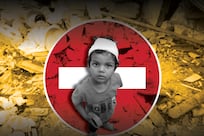"Painting is not made to decorate apartments," said Pablo Picasso in 1945. "It is an offensive and defensive instrument of war against the enemy." If so, his masterpiece Guernica - a response to the barbaric bombing of the Basque town by German and Italian warplanes during the Spanish Civil War - was a tactical nuclear strike. Later, Picasso joined the French Communist Party and drew the dove that would become the international symbol for peace. And yet, somehow, it's taken the Tate Liverpool's Picasso: Peace and Freedom exhibition for a gallery to look in detail at the links between the art and the politics of perhaps the most famous artist of the 20th century.
These days, most international shows focusing on important artists are obsessed with exploring an angle. It's no longer good enough just to show a selection of their work in a room: there must be a theme, a message. Sometimes, that makes for interesting new insights into artists we thought we knew well, such as the recent exhibition The Real Van Gogh: The Artist and His Letters at London's Royal Academy. Too often, though, such studies creak under the weight of the imposed concept. So it's fascinating to see how two new exhibitions in the UK (the other is Picasso: The Mediterranean Years at London's Gagosian Gallery) approach the richly varied work of Picasso. Not least because it's only a year since the National Gallery in London held Picasso: Challenging the Past - a show that explored his fascination with the Old Masters. It's just two years since perhaps the most comprehensive Picasso exhibition ever, at Madrid's Reina Sofia museum.
There's enough at the Tate Liverpool, however, to suggest that an exploration of the exiled Spaniard's politics is a fruitful basis for an exhibition. The most prolific and influential artist of the 20th century, who was as comfortable with the abstract, metaphorical forms of cubist and surrealist painting as he was with ceramics and sculpture, is sometimes cast as something of an art-movement playboy - even though he was a card-carrying communist. But here, there's a whole room dedicated to the posters and literature he designed for the 1950s Peace Movement. He became interested in creating art for the people, his ceramic work an unspoken nod to the earthy simplicity of the common man.
Of course, if Picasso is to be placed into a political context, then the piece he's perhaps most famous for - the expansive mural Guernica - is crucial. It's not here - not least because it's too huge, important, and, it's said, too fragile to leave Reina Sofia. But its absence is not the elephant in the room it could have been, thanks to some clever curating. Guernica was the talk of the art world in 1937, and the Tate Liverpool's survey begins in 1944. The Second World War is still going on, and Picasso is the only modern artist of any importance to remain in Paris and confront - albeit subtly - the Nazi sensibility for "proper" art.
It's in this atmosphere that The Charnel House, Picasso's most obvious anti-war statement after Guernica, was painted - and it opens Peace and Freedom with some aplomb. Inspired by a film about a Spanish family murdered in their kitchen, but finished as the full horror of the concentration camps became clear, heaps of corpses meld into one awful mass. Obviously, The Charnel House is not as big as Guernica, but that's the real joy of this exhibition: it shows the more intimate side of an artist whose sheer output (estimated at 50,000 pieces) can sometimes be overpowering - or just plain monotonous. It's not often that the still life work of one of the most highly regarded painters in the world are the highlights of a show such as this - unless that artist is Vincent van Gogh. But the room full of Picasso's efforts is truly sensational: these are dark ruminations on mortality featuring skulls, goats, owls and slaughtered cockerels. Even the presence of an innocent vegetable in Still Life with Skull, Leeks and Pitcher (1945) doesn't lighten the mood; it's arranged to look like the bones in the skull and crossbones.
It comes as quite a relief to walk through to the next room, then, and see the doves from the late 1940s - especially when they're sitting on a sun-dappled window and inviting the viewer to gaze out on the lush blue Mediterranean. And it's work from this period - paintings, drawings, prints, sculpture and ceramics - that is the focus of the exhibition opening in the Gagosian this weekend. Picasso: The Mediterranean Years (1945-1962) charts the artist's frequent trips to the south of France, where he hung out with poets, artists and lots of admiring women and began his sculpture and ceramic work.
Picasso's grandson, Bernard Ruiz-Picasso, and his biographer, John Richardson, place huge importance upon the Mediterranean setting during these phases of his career. All of a sudden, the claustrophic greys and blacks that filled his canvases were ditched in favour of explosions of colour. It was during this period - as the Tate exhibition also reveals - that he felt comfortable and relaxed enough to take on some of the Old Masters.
In Liverpool, there's a room dedicated to Picasso's take on Las Meninas by Diego Velazquez, one of the most famous and important works in all Spanish art. Edouard Manet's Le Dejeuner sur l'Herbe from 1863 was also appropriated for Picasso's own ends - although how exactly that fits into the "political Picasso" theme is slightly tenuous. The Women of Algiers series, too, can be read as a comment on the Algerian uprising of 1954 and makes reference most obviously to Eugene Delacroix's The Women of Algiers. So these two exhibitions aren't so much competing with each other as complementary looks at a complex man constantly changing his outlook on life and the way he chose to depict it through art.
Picasso might not have wanted his work to hang on apartment walls, but walking through the Tate's shop at the end of its impressive exhibition, it's difficult not to ignore him - and buy the poster. - Picasso: Peace and Freedom is at the Tate Liverpool until August 30, 2010. It then tours to the Albertina, Vienna in September and Louisiana Museum Of Modern Art, Denmark, in February 2011. - Picasso: The Mediterranean Years is at the Gagosian Gallery, London, from June 4 to August 28 2010.




